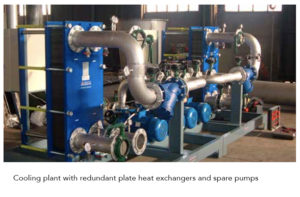

Thermoregulation and temperature control within production processes is an essential task that ensures the productivity of a plant. In some cases, is then suitable to prevent possible faults, or even to offer the possibility of not stopping the production during maintenance operations, for example the planned cleaning operations on plate heat exchangers serving the process. Aimed to prevent downtimes, is then suitable to foresee during the project phase the presence of redundancy of the employed thermal machines. For instance, it’s also possible to split and distribute the thermal duty among multiple machines having a smaller capacity, or otherwise installing a spare machine in parallel with the working one.
The common question here is if it’s better to have a unique chiller, evaporative tower, exchanger and so on, satisfying the entire thermal duty at 100%, or to prefer otherwise a two-machines solution each one working at the 50% of the needed thermal task.
The answer is subjective and depends on the kind of plant: when industrial production processes that can’t absolutely be interrupted are involved, the choice of multiple smaller machines installed in parallel should be mandatory. These customers usually already prevent any problem providing themselves from the beginning a security redundancy.
Anyway, even in this case there are different possible options, entailing different implications that have to be analyzed. Making a specific real case:
The required temperatures don’t allow the use of evaporative towers, so that the selection of refrigerators is obligatory. Considering the latitude of the installation, the implementation of a free cooling system can be economically interesting, in order to achieve a high energy saving during the cold season and limiting the functioning of the chiller during the mid-season.
From the point of view of the chiller, the thermal duty can easily be solved using a chiller with a capacity of 1.000 KW, condensed by air, equipped with a rotary-screw or centrifugal compressor. This is a simple solution but offering no escape, because in case of fault, the entire plant goes down. Of course, it is possible to suggest the customer to install two refrigerating groups, of which a second one in stand-by at the 100% of the thermal duty. But it means in fact a doubled investment, or almost.
The ideal solution would then seem to employ two refrigerating groups offering half the thermal capacity (500 KW), maybe multiple compressor type. There is anyway a problem, there is no spare equipment.
Hence the best solution is to install two refrigerating groups, each with 4 circuits, having a slightly higher capacity, for example 600 KW each. So that even in case of fault of one of the eight compressors, the customer still has the full design capacity required.

Of course, this kind of chillers have a higher cost compared to single compressor chillers, but they offer undeniable advantages:
The very same reasoning can thus be made with evaporative towers, with radiators (Tempco’s TCFC line has been deployed especially at this purpose with a modular concept on the number of fans), with plate heat exchangers, with pumps on pumping groups and so on.
Obviously, there are limits that must be evaluated case-by-case. In addition, these kind of solutions cannot clearly be deployed for small capacity plants. But, furthermore, here the risks related to machines downtimes are less pressing, and in case a redundancy of the machinery is required, it involves anyway lower investment costs even if doubled.